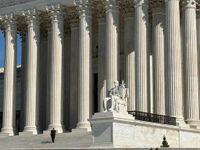On August 21, 2025, the Supreme Court issued a deeply divided ruling that temporarily allows the Trump administration to halt the disbursement of nearly $800 million in National Institutes of Health (NIH) research grants, many of which target issues of race, gender, and diversity. The decision, delivered on the court’s so-called emergency docket, marks a pivotal moment in the ongoing national debate over diversity, equity, and inclusion (DEI) initiatives in federally funded research and education.
The case traces back to an executive order signed by President Donald Trump during the opening days of his second term. The order directed federal agencies to terminate grants or contracts that, in the administration’s words, “promote gender ideology” or “immoral race- and sex-based preferences under the guise of so-called” DEI efforts. According to CNN, NIH officials responded by terminating more than 1,700 grants they determined were connected to these issues, including studies on topics ranging from HIV stigma in Thailand to the impact of traffic pollution on dementia.
The move sparked immediate backlash. Democratic officials from 16 states, a coalition of public health advocacy groups, and numerous affected scientists filed lawsuits, arguing that the abrupt cancellations would devastate ongoing research and undermine public health. As NPR reported, these challengers accused the administration of breaking with the NIH’s longstanding tradition of political neutrality, with some calling the terminations "an ideological purge."
Initially, lower courts sided with the plaintiffs. U.S. District Judge William Young, a Reagan appointee, was particularly scathing in his assessment, stating that the government’s actions represented "arbitrary and capricious action." He noted, "President Donald Trump’s executive action didn’t even attempt to define DEI, but instead set it up as some sort of boogeyman." Judge Young concluded that the administration had failed to provide the reasoned decision-making required by federal law, temporarily reinstating the grants. The 1st U.S. Circuit Court of Appeals declined to halt this ruling, setting the stage for the Supreme Court showdown.
On Thursday, the nation’s highest court reversed course in a 5-4 decision, at least for now. Chief Justice John Roberts joined the three liberal justices in seeking to deny the administration’s request entirely, while four of the court’s conservative members—Justices Clarence Thomas, Samuel Alito, Neil Gorsuch, and Brett Kavanaugh—fully sided with the administration. Justice Amy Coney Barrett, however, provided the pivotal vote, splitting the difference in a nuanced concurrence.
According to Steve Vladeck, a Supreme Court analyst cited by CNN, "the key to this ruling is Justice Amy Coney Barrett." Barrett argued that while the grant recipients may ultimately prevail in their legal challenge, they must bring their claims in the Court of Federal Claims rather than in district courts. This technical jurisdictional issue means that, for now, the grants remain frozen, but the door remains open for future legal victories by the affected researchers.
Justice Ketanji Brown Jackson, in a sharply worded dissent, warned of the real-world impact of the decision. She described the move as "an abrupt cancellation of hundreds of millions of dollars allocated to support life-saving biomedical research." In her view, the majority’s approach amounted to what she called "Calvinball jurisprudence with a twist," referencing the comic strip Calvin and Hobbes to highlight what she saw as a lack of consistent legal rules. "We seem to have two: that one, and this administration always wins," Jackson wrote.
Both sides in the legal battle highlighted the stakes in their arguments to the court. The Trump administration insisted it would be “irreparably harmed when forced to pay out millions of dollars on discretionary grants, with no guarantee of recouping the money.” They also argued, as Deadline noted, that lower courts were overstepping by substituting their own policy judgments for those of the executive branch. The administration drew parallels to a similar Supreme Court decision from April 2025, when the justices allowed the Department of Education to freeze $65 million in DEI-related grants while litigation continued.
Opponents, however, said the administration’s actions threatened to inflict "incalculable losses in public health and human life because of delays in bringing the fruits of Plaintiffs’ research to Americans who desperately await clinical advancements," according to filings from the American Public Health Association and other groups. An amicus brief from nonprofit biological and biomedical societies described "irreparable injuries already rippling across the scientific community due to the mass termination of NIH grants." Public health groups further argued that the government had failed to engage in the reasoned decision-making required by the Administrative Procedure Act, a point echoed by Judge Young in his district court ruling.
The Supreme Court’s order also left in place a lower court decision that vacated the administration’s guidance documents central to the grant cancellations. This means that while the grant money remains frozen for now, federal agencies cannot rely on the controversial guidance to cancel additional grants in the future. Justice Jackson noted that future parties "might see some benefit" from this outcome, but lamented that "the plaintiffs who filed the lawsuit will see none."
Beyond the immediate impact on scientific research, the case has broader implications for the reach of presidential power and the role of the courts in checking executive action. Trump Solicitor General John Sauer argued that the case exemplified a pattern of lower courts disregarding Supreme Court precedent, stating, "This application presents a particularly clear case for this Court to intervene and stop errant district courts from continuing to disregard this Court’s rulings." Plaintiff states countered that the only unlawful decisions were those of the federal government, accusing the administration of manufacturing a sense of urgency to justify its policies.
The NIH, for its part, maintained that it has the authority to terminate awards that do not support agency objectives or policies, as outlined in its Notice of Award stipulations. Yet, as NPR highlighted, critics argue that the Trump administration’s actions break with a "historical norm of a largely apolitical scientific research agency" and risk undermining the nation’s biomedical research infrastructure for years to come.
As litigation continues, the fate of nearly $800 million in NIH research funding—and the future of DEI-related federal grants—hangs in the balance. The Supreme Court’s fractured decision leaves both sides with a measure of hope and uncertainty, with the possibility of further legal battles looming on the horizon. For the scientists, advocacy groups, and patients awaiting the results of this research, the stakes could hardly be higher.

